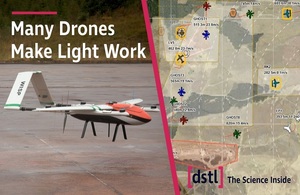Press release
A swarm of 20 drones, composed of 5 different types, with different operational capabilities has recently completed the largest collaborative, military focused evaluation of swarming Uncrewed Aerial Vehicles (UAVs) in the UK.

Drone graphic
The exercise was the culmination of the Defence Science and Technology Laboratory (Dstl)’s ‘Many Drones Make Light Work’ competition, funded under the MOD’s Science and Technology Portfolio through the Defence and Security Accelerator (DASA). Following 2 earlier phases, the £2.5 million contract for Phase 3 was awarded in January 2019. This was for an Integrated Concept Evaluation activity to explore the technical feasibility and military utility of a swarm of up to 20 small UAVs operating collaboratively. This was awarded to an industry team led by Blue Bear Systems Research including Plextek DTS, IQHQ, Airbus and Durham University.
The swarm consisted of 5 different types and sizes of fixed wing drones together with 6 different payload types, flying representative tasks at RAF Spadeadam in Cumbria. Three operators in Blue Bear’s Mobile Command & Control System (MCCS) managed the entire swarm whilst simultaneously handling different, collaborative payload analysis tasks.
The UAVs flew simultaneous Beyond Visual Line Of Sight (BVLOS) cooperative tasks, with Blue Bear collaborative autonomy ensuring they all contributed to overall mission goals. Throughout the 2 weeks of trials, more than 220 sorties were undertaken.
The Dstl Project Technical Authority, said:
Dstl has been driving research in autonomous systems across different platforms and domains for many years. This is a significant step forward in our understanding of the capabilities of swarming drones and has been achieved through excellent collaboration across the MOD and with a number of Small and Medium Enterprise partners. This 18 month collaboration has resulted in the demonstration of an operationally relevant capability and will inform and de-risk future choices and decisions about swarming drone capability.
Published 28 January 2021
Follow this news feed: HM Government





